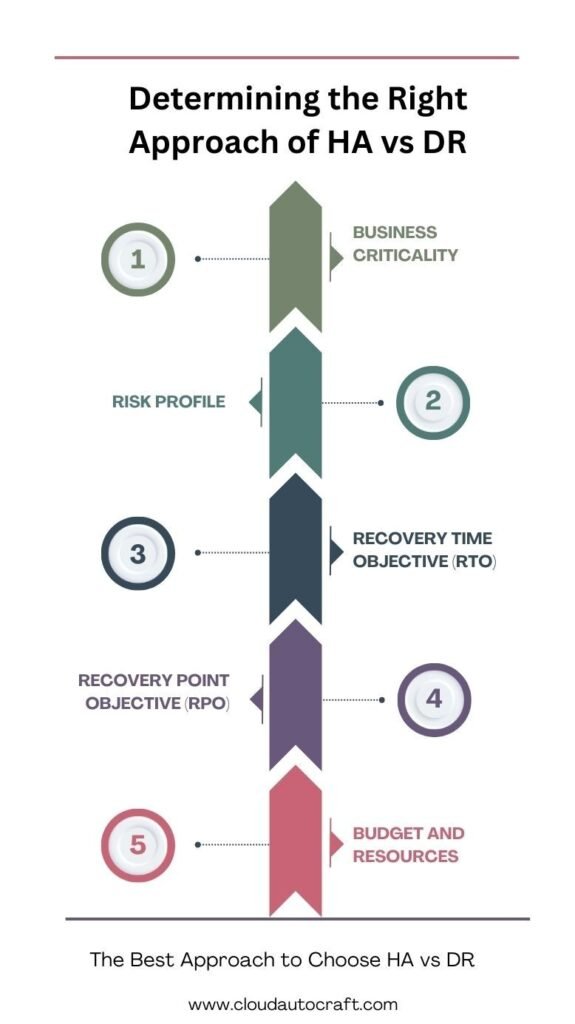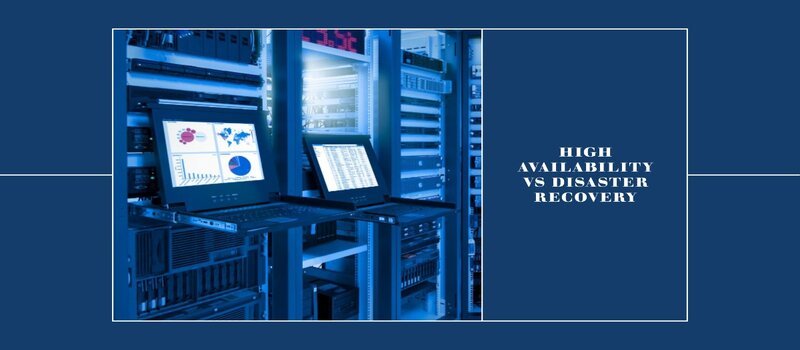Content:
- Introduction
- An Overview of High Availability vs Disaster Recovery
- Differences Between High Availability vs Disaster Recovery
- The Right Approach – High Availability vs Disaster Recovery
- Technical Solutions for HA and DR
- Case Studies and Examples
- Best Practices of High Availability vs Disaster Recovery
- Conclusion of High Availability vs Disaster Recovery
- FAQs:
- How do High Availability vs Disaster Recovery differ in their focus?
- What's the main distinction between the timescales of High Availability vs Disaster Recovery?
- How do the costs of implementing HA and DR solutions typically differ?
- What are some key factors to consider when deciding between HA and DR for your business?
Introduction
Two key strategies for protecting your business operations are High Availability vs Disaster Recovery. Although both aim to keep your critical systems up and running, they take different approaches and offer various levels of protection. In this blog post, we’ll break down what HA and DR are all about, highlight their differences, and guide you in choosing the best solution for your business.
An Overview of High Availability vs Disaster Recovery
What Does High Availability Mean?
High Availability (HA) focuses on keeping your systems and applications running with minimal downtime. Specifically, it aims to ensure your services are always accessible and operational. To achieve this, HA eliminates any single points of failure and provides a seamless, uninterrupted experience for your customers or users.
HA achieves this through redundancy, failover mechanisms, and load balancing. For instance, if one server in a cluster fails, the remaining servers automatically take over the workload. As a result, your services stay available without any noticeable disruptions.
Key Components of High Availability
- Redundancy: Redundancy is all about having backups so you’re never left high and dry. For instance, if you have multiple servers in different locations, you won’t be stuck if one fails. Instead, the others will pick up the slack.
- Failover Systems: Failover systems automatically switch to a backup when the main system fails. Think of it as having a backup quarterback on standby in case the starter gets injured. In the same way, this smooth transition keeps your services running without a hitch.
What Does Disaster Recovery Entail?
On the other hand, Disaster Recovery (DR) is all about getting your systems and data back on track after a major incident, like a natural disaster, cyber-attack, or hardware failure. In other words, think of DR as your backup plan for when things go wrong. It’s focused on being ready to bounce back and resume normal operations, even in the face of significant issues.
To achieve this, DR plans usually involve keeping backups at a different location, having backup data centres or cloud systems ready, and practising restoration procedures. Thus, this approach ensures that your important data and applications experience minimal downtime and data loss.
Key Components of Disaster Recovery
- Backup Strategies: Regular backups are essential—like an insurance policy for your data. In other words, you can easily restore from these backups and minimize data loss if anything goes wrong.
- Recovery Plans: A solid recovery plan outlines the steps to take in the aftermath of a disaster. Consider it a step-by-step guide that helps you get back on track quickly and smoothly.
Differences Between High Availability vs Disaster Recovery
Now that we’ve defined High Availability (HA) and Disaster Recovery(DR), let’s explore the key differences between these two approaches:
- Focus: HA is all about keeping things running smoothly and avoiding downtime. It ensures that your systems stay up and running even if something goes wrong. DR, on the other hand, is like your safety net for when something major happens. It’s focused on getting everything back up and running after a big disaster.
- Scope: HA usually deals with keeping a specific system or app running. It’s like having backup plans just for that one thing. DR looks at the bigger picture, covering everything from your entire infrastructure to your data, including how you back it up and get it back after something goes wrong.
- Timescale: HA is designed to deal with short-term problems, like a server going down or a network glitch. It aims to fix these issues almost instantly. DR handles bigger, longer-term problems, like major system failures or natural disasters, which can take hours or even days to recover fully.
- Recovery Time: With HA, you can expect things to failover almost immediately, often in seconds or minutes. DR might take a bit longer to get everything back to normal, depending on the size of the issue—usually from hours to days.
- Data Loss: HA focuses on preventing data loss by keeping multiple, up-to-date copies of your data. DR is more about getting your data back and reducing the data you might lose if something goes wrong.
- Cost: HA can be cheaper because it often involves having backups within the same infrastructure or nearby. DR usually requires a separate off-site setup, which can be more expensive due to the extra infrastructure and maintenance.
Click here to get more insight about How to Design High Availability & Disaster Recovery
The Right Approach – High Availability vs Disaster Recovery
Now that you’ve got a handle on the key differences between High Availability (HA) and Disaster Recovery (DR), it’s time to figure out which approach suits your business best. Therefore, Here are a few factors below which you can consider:

- Business Criticality: Consider the importance of your systems and applications to your operations. If they’re crucial to your business, investing in HA solutions might be worth it to keep everything running smoothly.
- Risk Profile: Look at the risks your business faces, such as natural disasters, cyber-attacks, or hardware failures. The higher the risk, the more you need a solid DR plan to cover all bases.
- Recovery Time Objective (RTO): Decide how long your business can handle without access to critical systems or data. HA is ideal for shorter recovery times, while DR is better if you need more time to recover.
- Recovery Point Objective (RPO): Assess how much data loss you can tolerate if something goes wrong. While HA minimises data loss in real-time, DR is about restoring data with minimal gaps.
- Budget and Resources: Consider how much you can invest in these solutions. Although HA might be more cost-effective, DR could require a bigger budget for infrastructure and detailed planning.
Technical Solutions for HA and DR
You’ll use a mix of technologies and strategies when setting up High Availability (HA) and Disaster Recovery (DR) solutions. Here’s a look at some common approaches:
High Availability (HA):
- Redundant Hardware and Infrastructure: First, ensure extra equipment and systems are ready to take over if something fails.
- Load Balancing and Failover Mechanisms: Additionally, distribute workloads across multiple servers and switch to backups automatically if needed.
- Clustering and Replication Technologies: Furthermore, group servers together to work as a single unit, replicating data to ensure it’s always available.
- Containerization and Orchestration Platforms (e.g., Kubernetes): Lastly, utilize containers to run applications consistently across different environments and manage them efficiently with orchestration tools.
Disaster Recovery (DR):
- Off-Site Data Backups and Storage: Keep backups in a different location to recover your data if something happens to the primary site.
- Replicated Data Centers or Cloud Infrastructure: Moreover, set up duplicate data centres or use cloud services to ensure a backup environment is ready.
- Automated Recovery and Failover Processes: Employ automation to quickly switch to backup systems and restore operations after an incident.
- Disaster Recovery as a Service (DRaaS) Solutions: Finally, consider third-party services that offer comprehensive disaster recovery solutions, managing backups and recovery for you.
Case Studies and Examples
High Availability in Practice:
Think about big tech companies like Google or Amazon. They heavily rely on high-availability strategies to keep their services running smoothly. For instance, they use multiple data centres and redundant systems so that if one part fails, others can take over. As a result, this setup ensures their services stay online and reliable.
Disaster Recovery in Practice:
Consider a financial institution that experienced a major data breach. In this case, their Disaster Recovery plan kicked in, involving restoring data from backups and keeping customers informed. Thus, this strategy enabled them to swiftly bounce back from the incident and reduce the impact on their operations.
Best Practices of High Availability vs Disaster Recovery
Implementing High Availability:
- Regular Testing: Test your failover systems to ensure they’re ready to jump into action when needed.
- System Monitoring: Use monitoring tools to monitor your systems and catch any issues early.
Implementing Disaster Recovery:
- Conduct Drills: Regularly practice your recovery plan, so everyone knows what to do when a real disaster strikes.
- Detailed Planning: Create a thorough recovery plan covering different scenarios, ensuring you have prepared for various incidents.
Conclusion of High Availability vs Disaster Recovery
In conclusion, High Availability and Disaster Recovery are essential for keeping your business running smoothly, but they serve different roles. Specifically, High Availability aims to prevent downtime and keep operations continuous, while Disaster Recovery helps you get back on track after major disruptions.
Therefore, choosing the right approach depends on your unique needs, budget, and how much risk you’re willing to take. Investing in both strategies can provide a strong framework to manage risks and ensure your business can survive and thrive even when faced with challenges.
Click here to get more insight about How to Implement Cloud Native DevOps with Kubernetes && How to Enhance More Kubernetes for App Deployment
FAQs:
How do High Availability vs Disaster Recovery differ in their focus?
Answer: The main difference is that High Availability (HA) is about preventing downtime and keeping your systems running smoothly all the time. In other words, it focuses on avoiding disruptions. On the other hand, Disaster Recovery (DR) is all about getting your systems and data back up and running after a major incident. While HA aims to stop problems before they happen, DR deals with recovering from them.
What’s the main distinction between the timescales of High Availability vs Disaster Recovery?
Answer: HA handles immediate, short-term disruptions, often fixing issues in seconds or minutes. In contrast, DR addresses long-term, large-scale problems that might take hours or even days to resolve fully.
How do the costs of implementing HA and DR solutions typically differ?
Answer: Generally, HA solutions tend to be less expensive than a full DR plan. HA usually involves setting up redundancy within the same infrastructure or nearby, which is more cost-effective. In contrast, DR often requires maintaining a separate, off-site infrastructure, making it more costly.
What are some key factors to consider when deciding between HA and DR for your business?
Answer: When choosing between High Availability (HA) and Disaster Recovery (DR), consider a few key factors: how crucial your business’s systems are, the risks you might face, your goals for recovery time and data loss, and the budget and resources you have. Taking these aspects into account will help you find the right mix of HA and DR, which is essential for a solid business continuity plan.
Originally posted 2024-08-02 19:19:27.


1 thought on “High Availability vs Disaster Recovery: Which Is Better”